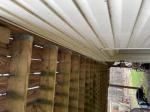Properly spacing deck boards
I am replacing the boards on my deck as they are beginning to rot and I have several boards that have busted through. When I put the deck in, it was done by a friend.
The problem is some of the boards have no space between them, and some do.
As I'm replacing the boards I want to get a good look, so I'm wondering if it's better to have a space between each deck board, or should I flush them up together, and if a space is recommended, what is the recommended spacing?
Editor's Comments:
This is a good question that a lot of people often wonder about. Fortunately today there are lots of very good tips, techniques and even some affordable solutions if you want to go that far.
Recommended Gaps Between Boards
Spacing the deck boards is important because it allows water to flow through the boards keeping them drier over their lifespan. A gap of 3/32" (just a tad bigger than 1/8") is a typical spacing and you can acheive that easily when you use almost any of the side mounted decking clips or fastener systems.
Wet Wood
When you lay down wet lumber it is possible to but them up tightly against each other and then let nature take its course. As the boards dry you will easily end up with at least 1/8 to 1/4" gap between each board because of shrinkage.
Yellow pine will create the largest gaps because it tends to move the most. Harder woods that retain less water and are more stable will shrink a little bit less.
Composite and synthetic decking will remain virtually unchanged.
Deck Fasteners That Automatically Space Boards
There has literally been a proliferation of side mounted clips that secure decking to the joists and hide themselves and automatically space the boards.
Here is a list of ones that come to mind:
Trex
Ipe Clips
Fiberon
Camo Fastening System
Mantis
And then there are private label versions of these that are designed to work with a manufacturers own decking material. Any one of these will space the boards properly.
Rotting Between Boards
You mentioned that your boards were rotting through. Presumably this is because water and or wet debris accumulated on the joist between the boards.
This is the perfect spot for rot to begin as the conditions are just right.
Using any of the above connecters should virtually eliminate the chance of any wet debris accumulating in that space.
Joist Rot Protection
Alternatively there are some clips that lock on over the joists, lock under the decking so that never fall off, shed debris and space each board at 3/32".
We have some of these at our store. They can be used with the Camo Fastening system so you still can toe-nail the boards in place.
Lots of options abound in this area. I hope this helps answer your question.
Comments for Properly spacing deck boards
|
||
|
||
|
||
|
||



























